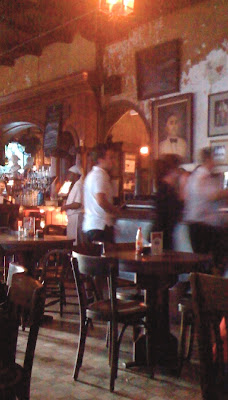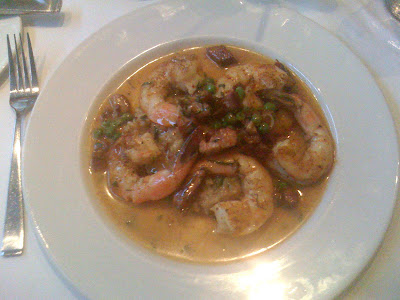
Taking a look around the main barroom in the front of the building, one easily gets the impression that changes have been few, if any, and that over the past century, the total expenditure on decorations might approach twenty bucks.
Napoleon House is more of a saloon than a restaurant, but more than that, it is perhaps the city’s ultimate exemplar of democracy in action.
It’s not uncommon to see local residents in business dress and tourists sporting flip-flops and fanny packs at adjacent tables blithely ignoring each other in a laissez faire environment that is more advertised than realized in “the city that care forgot.”
In truth, many New Orleans residents have conceded their beloved Vieux Carre (the French Quarter) to the masses who make tourism one of the city’s largest industries. Beyond an occasional foray to such bastions of the city’s old ways as Galatoire’s and Antoine’s, or a visit to see why people are buzzing about a new chef on the block, many locals have come to regard the Quarter as a place to bring company from out of town before returning to the relative equanimity of their own neighborhoods.
With the city’s carefully cultivated image as a hotbed of decadence, drunkenness and debauchery, it should not surprise anyone when the French Quarter becomes a magnet for visitors far from home intent on giving their repressed hometown behavior a test drive or, at the very least, watch others try their hands at the wheel. In fact, it can be convincingly argued that before Las Vegas unleashed its randy “what happens in Vegas stays in Vegas” advertising campaign, New Orleans was widely regarded as America’s “sin city.” Considering such a pedigree, it’s not difficult to see why local residents keep a wary eye on tourists; nor should it come as a surprise that their outings into the Quarter are commonly infrequent.
Yet in the heart of the packaged prurience of the French Quarter, a mere two blocks above Jackson Square on Chartres Street, is this oasis of civility, gentility and tranquility. And to many people, resident and visitor alike, there is no other place that typifies New Orleans as does the ramshackle bar that, were it in any other city, would be a likely candidate for the wrecking ball.
The 200 year-old building was originally the home of mayor Nicholas Girod, whose term in office (1812-1815) overlapped the historic Battle of New Orleans. A loyal Bonapartist, Girod offered his house as a home to Napoleon, who was in his second exile on the island of St. Helena, 1200 miles west of the African coast in the middle of the south Atlantic. Legend has it that Girod was trying to hatch a plot to spring Napoleon from captivity when “the little corporal” up and died, rendering the entire enterprise theoretical.
In 1914, the Impastato family opened their bar and restaurant in the building, where it has been in operation ever since. Taking a look around the main barroom in the front of the building, one easily gets the impression that changes have been few, if any, and that over the past century, the total expenditure on decorations might approach twenty bucks. The plaster and paint have nearly disappeared, often replaced by overlapping strata of graffiti. Paintings, posters and photographs go from fading to yellowing to thoroughly obscured by the thick brown patina arising from decades of heat, humidity and smoke.
French doors open off the St. Louis Street side of the barroom providing a view of one of the city’s most notorious slave exchanges, and on pleasant days, wobbly tables and rickety chairs inch their way through them to start forming an impromptu sidewalk café, where time slows and the temptation of one more final cocktail keeps the ringside seats from turning over at a Twenty-First Century clip. Mules pull carriages filled with tourists past the St. Louis Street tables and someone listening closely to the patter of the coachmen will learn a different history of the building over the rhythmic clopping of hooves with the passing of each coach.
In the midst of the city where jazz was cradled, American gospel planted its roots and a joyous Cajun zydeco beat pounds out the front of trinket shops, Napoleon House is a defiant anachronism. The music in the barroom is big boy classical – a thundering Beethoven symphony one minute, Pavarotti powering through a Puccini aria the next – and there is a fundamental rightness to the music that is undeniable. In nearly forty years, I’ve never heard anyone have the temerity to suggest switching it to rock, funk or (God forbid) country. It’s as if a cantankerous specter stands sentry in the room, ready to advise a musical philistine that there are several dozen other places in the Quarter that play the new stuff and the door is in the corner.
There is a smallish courtyard behind the barroom, a room to the side that once housed a bistro with a more ambitious menu than that of the saloon but has yet to reopen after Katrina, and there are also private event rooms in the 2300 square feet on the second floor that were once fit and fitted for an emperor. And while these areas are all very pleasant and New Orleans-esque in their own right, none of them bespeak the Crescent City as declaratively as the bar.
One thing missing from Napoleon House, but not really missed at all, is the ubiquitous display of photographs of people both famous and infamous who have frittered away an hour or a lazy afternoon going all the way back to the year Archduke Franz Ferdinand was shot dead in Sarajevo and the world plunged into war. While many places cover their walls with pictures of presidents and popes, silent stars of the silver screen or television’s talking heads, the lack of same at Napoleon House tacitly implies that this is an egalitarian saloon, one where the owners don’t give a damn who you are as long as you have enough money to buy a drink and the common sense to leave everyone else alone.
This streak of iconoclasm seems to permeate the wait staff, a polite yet slightly standoffish crew of men in white shirts and black bow ties. Waiters whose demeanors border on the dictatorial are more of a tradition than a novelty in New Orleans to be sure, but in a venerable old joint like Napoleon House, such behavior can be oddly reassuring instead of off-putting, although it can be slightly disconcerting for men of any age, including octogenarians, to be called “young man” by a proper but prissy waiter whose sexuality could easily be grounds for debate.
There is food at Napoleon House and it’s far better than anyone walking through the door for the first time might expect in such a timeworn establishment. Non-cognoscenti of New Orleans’ culinary traditions have no reason to know that the operators of Napoleon House are a branch of the Impastato family, which also operates a renowned eponymous restaurant in Metairie and Sal & Judy’s, a prominent Creole-Italian trattoria across Lake Pontchartrain in the Northshore village of Lacombe.
There are salads, the influences of which leans toward Italian, ten predictable po’boys and such predictable New Orleans standards as jambalaya, gumbo and red beans and rice. More unusual, at last for tavern food, are the appetizers: focaccia, bruschetta, a café charcuterie, an antipasto salad, hummus and a cheese board with six wedges of cheese, pepperoni slices, fresh fruit and bread. Yet there is something so atmospheric and continental, not to mention appropriate, about appetizers with a European flair being served in a century old New Orleans bar with corroding pictures on the walls and Il Trovatore on the turntable.
The centerpiece of the menu, however, is the warmed Italian Muffuletta, a colossal sandwich created with ham, Genoa salami, pastrami, Swiss cheese, provolone and a garlicky housemade olive salad piled high on the split, round loaf of thickly crusted Italian bread from which the muffuletta derives its name. The consensus in New Orleans is that the muffuletta was originally conceived and built in 1906 at Central Grocery Co., an Italian market founded when lower Decatur Street was the heart of the dockside Italian community and which is still in business today.
In a city where the mere expression of a personal food preference can become the flashpoint for anything from a raised voice debate to occasional fisticuffs, an argument has raged for decades about the Central Grocery muffuletta’s superiority over the one served at Napoleon House and vice versa. The Central Grocery version is served at room temperature, which Napoleon House loyalists disparage as “passé,” while their version is heated to the point the cheeses melt, which the Central traditionalists decry as sacrilege. It is, of course, a good-natured argument that will never be won or lost but is destined to continue as long as there is meat, cheese, olive salad, bread and two New Orleanians to fight about it.
The specialty drink at Napoleon House is the Pimm’s Cup, actually invented in England in 1840 and more traditionally associated with Wimbledon and afternoon cricket matches, a cooling blend of Pimm’s No. 1 gin-based liqueur and three ounces of lemonade topped off with 7UP and garnished with cucumber. No one seems to know exactly how or when the Pimm’s Cup became the saloon’s liquid mascot, but in a place that takes yesteryear’s events at face value, no one really needs to. Some things are just the way they are, period.
In a few short years, Napoleon House will ease into its second century as a bar. If things stay the way they are, and if the past is prologue they will, not much if anything will change. There might be a small print ad and an extra article or two in The Times-Picayune, but beyond that, the Pimm’s Cup will continue to pour, the pictures will continue to age, and should a resident happen to make eye contact with a visitor there may even be a quick nod of recognition. But in a New Orleans that continues to change, who could possibly want Napoleon House to change along with it?
Raise your glass to democracy at its best. Hear, hear.
_________________________________________________
Napoleon House, 500 Chartres Street, (at St. Louis Street)
Monday 11 a.m. - 5:30 p.m; Tuesday through Thursday 11 a.m. -10 p.m;
Friday and Saturday 11 a.m. – 11 p.m.
All major credit cards accepted, but no reservations
Telephone: (504) 524-9752, Website: www.napoleonhouse.com






